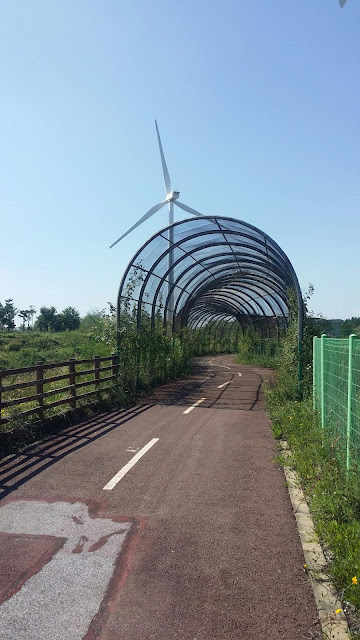Day 2 came to an end at about 2:05 p.m., which is when I arrived at the gijeom, i.e., the starting-point for the entire Gukto Jongju, or the bike path that starts in Incheon and ends in Busan at the Nakdong River Estuary. As you'll recall, my Seoul-Busan walk didn't begin at the beginning of the national bike path: because I had started in Seoul, there was an unfinished 60-some-kilometer stretch that I hadn't walked—the very stretch that I'm currently walking for the third time.
This set of photos shows the final-approach phase, so things may get a bit slow and repetitive as I savor the fact of my arrival. You'll see what I mean.
As I said previously, it's a bit more than three kilometers from the aforementioned Ara bridge to the very end of the bike path. Here's a sign showing that I have two kilometers to go:
When you see the wind turbines in the distance, you know your walk is almost over:
When wind turbines are visible from afar, you can be sure your journey is near its end:
When wind-driven power generators are visible from far off, it is evident that your trek has come close to reaching its terminus:
The big blue mama bear below marks the spot where the hyugeso (rest station) is located. This isn't where the trail ends: you have to walk over to the end of the path, then walk about 500 meters back to the blue bear if you're planning on buying food, using the restroom, etc.
For people who get turned on by thresholds, there are two trellis-like structures, including one that you see below, that cover part of the final kilometer of the path:
As I walked the final stretch. approaching the victory arch that marks the start/finish point of the Gukto Jongju, I glanced left at the sea and took in the sea-nery:
En avant for the final few meters:
A hundred meters to go. See the victory arch in the distance?
Here I am, unknowingly getting sunburned. The day started off cloudy and remained that way for a long time, but the sun finally took the situation seriously and began to burn the clouds away sometime during the late morning and early afternoon.
This pic comes from about 2:03 p.m.:
Weirdly enough, the victory arch doesn't mark the exact zero point. As you see in the pic below, we're still 55 meters from zero, so after taking my selfie, I lumbered the final few dozen meters to zero.
This, ladies and gents, is zero:
And here are me and my shadow to prove I was there:
One last look out at the water. As I've written before, finishing at Incheon is anticlimactic because you really don't get a nice, unobstructed view of the sea. Even in the photo below, where there's a stretch that appears to be open ocean, there's actually a man-made structure in the way—a causeway or something—that impedes one's view of the sea. Busan isn't much better: the endpoint is next to a huge tower, which is kind of cool, but you can't run up to a nearby beach and touch the water. For that, you have to go up the coast a ways, which is what I did. Anyway, yeah: this time around, I took a few victory photos and didn't even stick around to savor my victory: I simply headed straight to the rest area to grab lunch and then call a cab.
Boy, I bet people have mixed feelings about this marker, below, which bears the name of now-beleaguered ex-president Lee Myung-bak. If there's one thing President Lee loved doing, it was designing new ways to bisect areas by opening up waterways and/or paths of some sort. When he was mayor of Seoul, he pushed hard for the Cheonggyecheon project, which involved reopening a long-buried stream that runs through the heart of Seoul's northern downtown area. After much scoffing by the public and other detractors, and after much anger from the merchants whose shops and kiosks had to be moved to make way for the reopened stream, Lee reopened the Cheonggye Stream, which he had enhanced by turning it into a pedestrian zone. At first, when the city tried to stock the stream with fish, all the fish died, confirming, in many people's minds, that the project was an abject failure. Later on, though, with the help of some landscaping and some random acts of Mother Nature, plant life was introduced, the stream became sufficiently oxygenated, and fish could now be placed in the water. Today, the stream is a lively—if overcrowded—walking zone, somewhat charming at night if you can find some breathing room. Lee continued his bisecting binge as president, giving the nation a vision of a canal that would cut across the country, presumably to aid with shipping. There was a huge outcry against this, and the canal never happened. But the Gukto Jongju did, and I gather that Lee was a force behind that as well. For that, I'm exceedingly thankful. I would never have had my life-changing walk last year if Lee hadn't promoted a bike-friendly Korea. Whatever the man's failings, he did A Very Good Thing when he opened this (part of the) path.





















No comments:
Post a Comment
READ THIS BEFORE COMMENTING!
All comments are subject to approval before they are published, so they will not appear immediately. Comments should be civil, relevant, and substantive. Anonymous comments are not allowed and will be unceremoniously deleted. For more on my comments policy, please see this entry on my other blog.
AND A NEW RULE (per this post): comments critical of Trump's lying must include criticism of Biden's or Kamala's or some prominent leftie's lying on a one-for-one basis! Failure to be balanced means your comment will not be published.